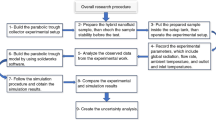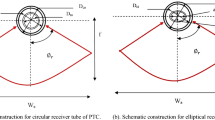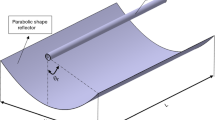Abstract
In this article, heat transfer enhancement of line focus solar collector with porous disc receiver is studied with water and therminol oil. A three dimensional (3-D) numerical simulation of porous disc enhanced receiver is carried out using commercial CFD software Fluent 6.3 to evolve the optimum configuration. The 3-D numerical model is solved by renormalization-group based k-ε turbulent model associated with standard wall function. The effect of porous disc receiver configurations (solid disc at bottom; porous disc at bottom; porous disc at top; and alternative porous disc) on performance of the trough concentrator is investigated. The effect of porous disc geometric parameters (φ, θ, W, H and t) and fluid parameters (Pr and m) on heat transfer enhancement of the receiver is also studied. The numerical simulation results show that the flow pattern around the solid and porous discs are entirely different and it significantly influences the local heat transfer coefficient. The porous disc receiver experiences low pressure drop as compared to that of solid disc receiver due to less obstruction. The optimum configuration of porous disc receiver enhances the heat transfer rate of 221 W m−1 and 13.5% with pumping penalty of 0.014 W m−1 for water and for therminol oil-55, heat transfer rate enhances of 575 W m−1 and 31.4% with pumping penalty of 0.074 W m−1 as compared to that of tubular receiver at the mass flow rate of 0.5 kg s−1. The Nusselt number and friction factor correlations are proposed for porous disc receiver to calculate heat transfer characteristics. The porous disc receiver can be used to increase the performance of solar parabolic trough concentrator.

























Similar content being viewed by others
Abbreviations
- Ac :
-
Cross sectional area of the receiver (m2)
- Ap :
-
Aperture area of the solar trough collector (m2)
- Ar :
-
Receiver area (m2)
- cF :
-
Forchheimer coefficient
- cp :
-
Specific heat at constant pressure (J kg−1 K−1)
- CR:
-
Concentration ratio of the collector
- \( C_{\varepsilon 1} ,C_{\varepsilon 2} ,C_{\mu } \) :
-
Turbulent model constants
- di :
-
Inner diameter of the receiver (m)
- do :
-
Outer diameter of the receiver (m)
- dp :
-
Diameter of the pore in the disc (m)
- D:
-
Glass cover diameter (m)
- f:
-
Friction factor
- H:
-
Height of the porous disc (m)
- hf :
-
Heat transfer coefficient at inner surface of the receiver (W m−2 K−1)
- Ib :
-
Beam radiation (W m−2)
- k:
-
Turbulent kinetic energy (J)
- Kp :
-
Permeability (m2)
- L:
-
Length of the receiver (m)
- m:
-
Mass flow rate (kg s−1)
- Nu:
-
Nusselt number
- ΔP:
-
Pressure drop (Pa)
- Pr:
-
Prandtl number
- Q:
-
Total heat transfer (W)
- \( q^{\prime \prime } \) :
-
Heat flux (W m−2)
- \( q_{ub}^{\prime \prime } \) :
-
Useful heat flux applied at bottom of the receiver (W m−2)
- \( q_{ut}^{\prime \prime } \) :
-
Useful heat flux applied at top of the receiver (W m−2)
- r:
-
Radius (m)
- Re:
-
Reynolds number
- S:
-
Magnitude of rate of strain
- t:
-
Thickness of the porous disc (m)
- T:
-
Temperature (K)
- Twi :
-
Inner wall temperature of the receiver (K)
- Two :
-
Outer wall temperature of the receiver (K)
- u, v, w:
-
Velocity (m s−1)
- Ul :
-
Overall heat loss coefficient (W m−2 K−1)
- V:
-
Velocity vector (m s−1)
- W:
-
Pitch of the porous discs (m)
- x, y:
-
Spatial position (m)
- α t :
-
Inverse of Prandtl number
- γ:
-
Intercept factor
- ε:
-
Turbulent dissipation rate (m2 s−3)
- θ:
-
Angle (deg)
- λ:
-
Thermal conductivity (W m−1 K−1)
- μ:
-
Viscosity of the fluid (Ns m−2)
- \( \upsilon_{eddy} \) :
-
Eddy viscosity (m2 s−1)
- \( \upsilon_{o} \) :
-
Molecular viscosity (m2 s−1)
- \( \upsilon_{t} \) :
-
Turbulent viscosity (m2 s−1)
- ρ:
-
Density (kg m−3)
- \( \rho_{g} \) :
-
Reflectivity of the glass
- φ:
-
Porosity
- ψ:
-
Turbulent model constant
- \( \left( {\tau \alpha } \right)_{b} \) :
-
Transmissivity-absorptivity product for beam radiation
- a:
-
Ambient
- CF:
-
Clear fluid
- f:
-
Fluid
- in:
-
Inlet
- int:
-
Interface
- i, j:
-
General spatial indices
- max:
-
Maximum
- PM:
-
Porous medium
- ref:
-
Reference
- s:
-
Solid
- T:
-
Therminol oil
- W:
-
Water
- WT:
-
Water and therminol oil
References
Clark JA (1982) An analysis of the technical and economic performance of a parabolic trough concentrator for solar industrial process heat application. Int J Heat Mass Transf 25:1427–1438
Thomas A (1994) Simple structure for parabolic trough concentrator. Energy Convers Manag 35:569–573
Riffelmann K, Neumann A, Ulmer S (2006) Performance enhancement of parabolic trough collectors by solar flux measurement in the focal region. Sol Energy 80:1303–1313
Omer SA, Infield DG (2000) Design and thermal analysis of a two stage solar concentrator for combined heat and thermoelectric power generation. Energy Convers Manag 41:737–756
Bakos GC (2006) Design and construction of a two-axis sun tracking system for parabolic trough collector (PTC) efficiency improvement. Renew Energy 31:2411–2421
Thomas A, Thomas SA (1994) Design data for the computation of thermal loss in the receiver of a parabolic trough concentrator. Energy Convers Manag 35:555–568
Odeh SD, Morrison GL, Behnia M (1998) Modelling of parabolic trough direct steam generation solar collectors. Sol Energy 62(6):395–406
Zhang QC, Zhao K, Zhang BC, Wang LF, Shen ZL, Zhou ZJ, Lu DQ, Xie DL, Li BF (1998) New cermet solar coatings for solar thermal electricity applications. Sol Energy 64:109–114
Al-Nimr MA, Alkam MK (1998) A modified tubeless solar collector partially filled with porous substrate. Renew Energy 13:165–173
Satyanarayana GV, Ravi Kumar K, Reddy KS (2007) Numerical study of porous enhanced receiver for solar parabolic trough collector. In: 3rd international conference on solar radiation and day lighting, vol 2, New Delhi, India, 7–9 February, pp 46–55
Reddy KS, Ravi Kumar K, Satyanarayana GV (2008) Numerical investigation of energy efficient receiver for solar parabolic trough concentrator. J Heat Transf Eng 29(11):961–972
Reddy KS, Satyanarayana GV (2008) Numerical study of porous finned receiver for solar parabolic trough concentrator. J Eng Appl Comput Fluid Mech 2(2):172–184
Ravi Kumar K, Reddy KS (2009) Thermal analysis of solar parabolic trough with porous disc receiver. Appl Energy 86:1804–1812
Ravi Kumar K, Reddy KS (2010) Investigation of heat transfer characteristics of line focus receiver with porous disc inserts for solar parabolic trough concentrator. In: Proceedings of the 20th national and 9th international ISHMT-ASME heat and mass transfer conference, January 4–6, 2010, Mumbai, India, pp 487–494
Incropera FP, DeWitt DP (2007) Fundamentals of heat and mass transfer, 5th edn. Wiley, Singapore, pp 325–368
Nield DA, Bejan A (1998) Convection in porous media. Spinger, New York
Yang YT, Hwang CZ (2003) Calculation of turbulent flow and heat transfer in a porous baffled channel. Int J heat Mass Transf 46:771–780
Biswas G, Eswaran V (2002) Turbulent flows fundamentals, experiments and modeling. Narosa publishing house, New Delhi, pp 342–363
Fluent Inc (2005) Fluent 6.3 user’s guide. Lebanon, NH
Zheng B, Lin CX, Ebadian MA (2003) Combined turbulent forced convection and thermal radiation in a curved pipe with uniform wall temperature. Numer Heat Transf 44:149–167
Antohe BV, Lage JL, Price DC, Weber RM (1997) Experimental determination of permeability and inertia co-efficient of mechanically compressed aluminum porous matrices. ASME J Fluids Eng 119:404–412
Lee SL, Yang JH (1997) Modeling of Darcy-Forchheimer drag for fluid flow across a bank of cylinders. Int J Heat Mass Transf 40:3149–3155
Dittus FW, Boelter LMK (1930) Heat transfer in automobile radiators of tubular type. Univ Calif Publ Eng 1(13):755–758
Sieder EN, Tate GE (1936) Heat transfer and pressure drop in liquids in tubes. Ind Eng Chem 28:1429–1435
Petukhov BS (1970) Heat transfer in turbulent pipe flow with variable physical properties. In: Irvine TF, Hartnett JP (eds) Advances in heat transfer, vol 6. Academic Press, New York, pp 504–564
Gnielinski V (1976) New equations for heat and mass transfer in turbulent pipe flow and channel flow. Int Chem Eng 16:359–368
Nasiruddin S, Siddiqui MHK (2007) Heat transfer augmentation in a heat exchanger tube using a baffle. Int J Heat Fluid Flow 28:318–328
Wilson L, Narasimhan A, Venkateshan SP (2006) Permeability and form co efficient measurement of porous inserts with Non-Darcy using Non-Plug flow measurements. Trans ASME 128:638–642
Acknowledgement
The financial support provided by the Department of Science and Technology (DST, Govt. of India), New Delhi through the research project is duly acknowledged.
Author information
Authors and Affiliations
Corresponding author
Rights and permissions
About this article
Cite this article
Ravi Kumar, K., Reddy, K.S. Effect of porous disc receiver configurations on performance of solar parabolic trough concentrator. Heat Mass Transfer 48, 555–571 (2012). https://doi.org/10.1007/s00231-011-0903-8
Received:
Accepted:
Published:
Issue Date:
DOI: https://doi.org/10.1007/s00231-011-0903-8




